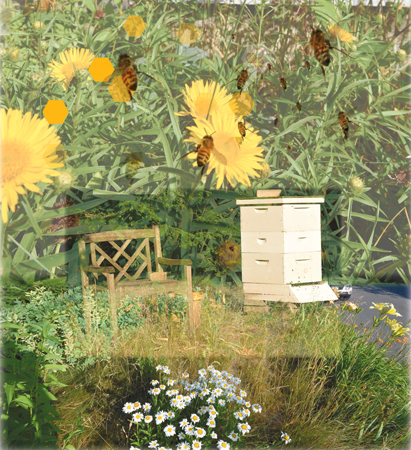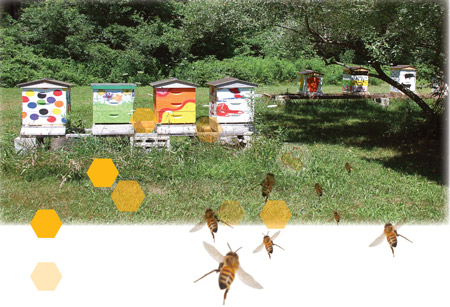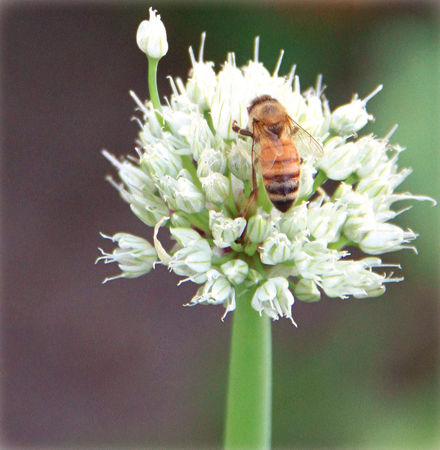KEEP SUSTAINABLE GARDENS GROWING
 Having been a Realtor since 1992, purchasing my home in 2007 was born of a desire to not only become a homeowner myself, but also to grow my own garden that would thrive on bird and bee pollination of wildflowers and herbs. The house itself is heavily insulated and air-sealed to reduce heating costs and carbon emissions, and solar roof panels generate all electricity affordably and sustainably.
Having been a Realtor since 1992, purchasing my home in 2007 was born of a desire to not only become a homeowner myself, but also to grow my own garden that would thrive on bird and bee pollination of wildflowers and herbs. The house itself is heavily insulated and air-sealed to reduce heating costs and carbon emissions, and solar roof panels generate all electricity affordably and sustainably.
I wanted my garden to be sustainable as well—a symbiotic relationship among plants, insects, and birds made pollination the best way to achieve this. Shunning the chemical fertilizers and pesticides Rachel Carson had condemned in her seminal book, Silent Spring, and luring in birds, bees, and predator insects to perform the pollination and pest control necessary to yield produce, proliferate wildflowers, and sustain wildlife ecologically. The flowers also had to be fertilized as organically as possible. Furthermore, since the 6,000 square-foot property was once part of a farm, justice to its heritage was important.
To begin, my garden had to have something in bloom each season, providing seeds and berries year-round to attract the desired living creatures. Plants were spaced amply to avoid parasitism and arranged carefully so each species could blossom and bear fruit in its proper season. Most are native plants, which typically use less water and fertilizer than cultivars and grass lawns. Natives also adapt best to local water, climate, and soil conditions as well as provide preferred food for birds and insects. In keeping with my desire for a sustainable garden, I use a compost of yard waste, biodegradable food waste, Wollaston seaweed and seashells, and manure from stables near the Blue Hills Reservation to feed the garden plants. This helps to keep down chemical pollution created by  fertilizer runoff and recycles organic material in the garden.
fertilizer runoff and recycles organic material in the garden.
A Pollination Primer
The variety of pollinators in the United States is impressive: there are over 400 types of native and non-native bees, not to mention all the flies, moths, butterflies, and birds that serve as pollinators.
Each pollinator gravitates to different types of flowers, their favorite plants tending to bloom at different times of the year. For example, spring crocuses are early sources of nectar and pollen (both are pollinator food), coneflowers are a wonderful summer food source, and goldenrod and asters provide autumn sustenance. Considering bloom times helps the gardener to design a sustainable, multi-season garden that pollinators also can call home.
Four years ago, beehives were introduced to the property to produce honey and beeswax. This resulted in incorporating more native and pollinator plants.
To fully capitalize on the bees’ benefits—and to shield my bee colonies from the public eye, lest they drive people away from my property—a home was set up for them: an apiary, or hive-housing. And that recalled the challenge of house-hunting. The apiary had to be placed precisely within the bees’ forage range for seeking nectar and pollen from the flowers, which meant sheltering it from prevailing winds that would impede bee flights to the flowers. Also, the apiary had to be far enough away from the nearby brook and pond so that the air would not become too moist and stagnant; otherwise, it would hamper bee flight speeds, which average 15 mph.
The best site was a few feet from a row of backyard trees and bushes: it provided the requisite windbreak without shading the apiary too much and wouldn’t get too damp. Dried stalks from the aster species coneflower (Echinacea) provide an additional nest for native bees such as the Mason Bee.
Loving butterflies, too, for their beauty and pollination power, I planted Dutchman’s pipe (Aristolochia macrophylla) as their landing spot. The majestic monarch butterfly alights on milkweed (Asclepias tuberosa)—sometimes called “butterfly weed”—which demonstrates that many wildflowers do not deserve their “weed” reputation.
The Bees Have It
Contrary to the belief of some, bees are not “pests”; they benefit both flowers and folks. As the only insects cultivated by farmers since the Egyptians built the pyramids, the honeybee produces honey and beeswax for human consumption after sipping nectar and ingesting pollen for food. In the process, they pollinate flowers, vegetables and herbs by brushing against a plant’s reproductive parts, leaving behind a previous plant’s pollen. This causes the present plant to seed, proliferate, and preserve its species. The bees carry both the pollen and the nectar back to the hive to be consumed by all the bees in the apiary. Extra pollen (protein source) and nectar (carbohydrate source) are converted to honey and wax. While most of the honey is stored for the bees to eat during the cold winter months, some is harvested by the beekeeper for his or her own use.
Bees contribute to our health in return, since their pollination cultivates more fruits, vegetables, and herbs. In fact, about 75 percent of our food needs pollination from insects and birds to remain plentiful: almonds, apples, carrots, cherries, cucumbers, grapes, grapefruits, oranges, pears, peppers, raspberries, strawberries, tomatoes . . . the list goes on.

Reaching Sustainability
Now my garden has more than 25 indigenous and hybrid plant types offering a potpourri of visual delights, herb choices, and bird, bee, and butterfly species. Orange-red trumpet vine (Campsis) attracts hummingbirds, which are prime pollinators. With their long, sharp beaks they penetrate deeply into the flowers to sip nectar for nutrition, emerge with pollen-encrusted faces, and transfer the pollen to other flowers while imbibing from them, thus proliferating the flower population for more pollination. Midsummer pollinator plants include purplish lupine (Lupinus), lavender-white beardtongues (Penstemon), yellow black-eyed Susans (Rubbeckia hirta), and mountain mint (Pycnanthemum muticum), which attract predators like ladybugs for natural pest control. Clematis (Clematis virginiana) lures bees in late summer: autumn joy (Sedum) in late summer to early fall. Autumn pollinator plants include goldenrod (Solidago) and aster (Asteraceae).
Herbs in my garden include chives, garlic, mint, oregano, sage, and tarragon, all key for my seasoning and cooking needs. Bees pollinate their flowers as well, adding more to my honey jar and herb supply. True to Ms. Carson’s vision, the ladybug and praying mantis police pests off the plants: aphids, grasshoppers, leafhoppers, mosquitoes, and moths (although moths are pollinators, too). A few birds, such as hummingbirds, are pollinators but for the most part eat the seeds produced by the coneflowers and berries produced by the viburnum bushes. The birds consider the insects in the garden to be an excellent source of food.
By letting the pollination process run the show, a small piece of habitat has been restored to close to its original farm use, honoring colonial agriculture. The garden has evolved from an amateur plot to an ecological landscape that is self-sustaining in the way it harnesses some of nature’s essentials—plants, birds, insects—to support both human and environmental health through the symbiotic interrelationship among them. Neighbors have told me that their fruit trees have borne more fruit after pollination from the bees. And I often trade my honey and herbs for some of those fruits and vegetables that my garden helped to grow. Small-scale urban agriculture can create a sustainable food source right in our own backyards.
Disclosure: While my garden and honey cannot be considered truly organic, I do not use any chemicals in my beehives or in the rest of my garden. The manure may contain medicine or other chemicals ingested by the horses, and pollen and nectar from offsite flowers may have been chemically treated. After all, a bee’s full forage range for pollination and nectar collection is within a three-mile radius of its hive, and the garden does not have enough plants to fully support the hives.
WALNUT HONEY SQUARES Recipe

By: David Kelman is an avid home gardener and beekeeper. He recognizes (and sees) the clear link between plant and animal life in his Milton garden. David is a locally based Realtor with Keller Williams Realty Showcase Properties.






